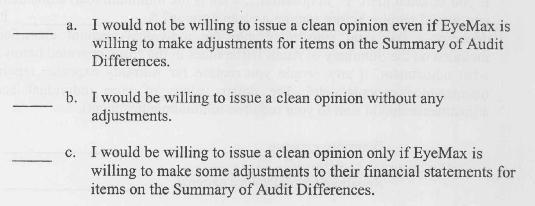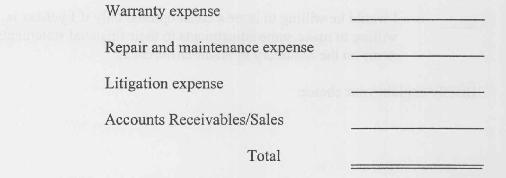The information below relates to the audit of EyeMax Corporation, a client with a calendar year-end. EyeMax
Question:
The information below relates to the audit of EyeMax Corporation, a client with a calendar year-end. EyeMax has debt agreements associated with publicly traded bonds that require audited financial statements. The company is currently, and historically has been, in compliance with the covenants in the debt agreements. Further, management believes that having audited financial statements prepared in accordance with GAAP is important to shareholders and is "simply a good business practice."
Assume that audit fieldwork has been completed. At this point you are considering several items that have been posted to a "Summary of Audit Differences." The Summary of Audit Differences is a listing auditors compile during an audit as they uncover potential or proposed corrections to the client's financial statements. Additional detailed information about the items posted to the Summary of Audit Differences is provided on the following pages. Based on the information provided, you will be asked to decide the minimum adjustment (if any) to the financial statements that would be necessary before issuing a "clean opinion."
Make sure you carefully consider materiality as you evaluate the misstatements because auditors do not require their clients to book immaterial adjustments. Therefore, even if, for example, a client has followed a non-GAAP procedure no adjustment would necessarily be required unless the impact is material (i.e., an individual adjustment(s) is greater than tolerable misstatement or aggregated sum of all misstatements are greater than overall materiality after considering relevant qualitative factors). At the end of this case you will also be asked several questions related to your decisions. Please carefully consider the following information before you answer the questions.
BACKGROUND
Nature of client's business. EyeMax is engaged in research and development, manufacture and sale of medical devices used by ophthalmologists during eye surgeries. Customers of the product lines are primarily doctors of ophthalmology and laser-eye clinics. The company was founded in 1984 by Wayne Carruth, MD, to produce and market a line of devices used in optic surgery that he designed. Several years ago, EyeMax began to exploit the future prospects of laser technology in optic surgery. EyeMax has grown rapidly, especially in recent years, and has made significant strides in market share. EyeMax is currently the third-largest supplier of optical equipment, with a \(25 \%\) market share, and employs 425 people, up from only 285 employees just two years ago. Thirty percent of the stock in EyeMax is owned by Wayne Carruth and his immediate family. Approximately, 40 percent of the stock is owned by company employees, with the largest individual holding equal to about ten percent of the company's shares. Venture capitalists and a few outside investors hold the remaining shares. The company's shares currently trade on the over-thecounter bulletin-board market. \({ }^{1}\)
Accounting environment, risk assessments, and audit approach. The accounting department employs eight people: The controller is a CPA, the accounting supervisor and payroll supervisor each have college degrees in business, and the remaining five clerks have limited training and experience. Although the company has no material weaknesses in internal controls, the accounting department has not kept pace with the demands created by growth in production and sales. The department is overworked. Key controls appear to be functioning but are not always performed on a timely basis. In the planning phase of the audit, both inherent risk and control risk were assessed at less than the maximum, but the audit plan specifies an audit approach that relies primarily on substantive testing.
Management's position regarding audit adjustments. EyeMax has been an audit client for five years. Prior audits have generally detected accounting misstatements, and EyeMax's management has readily made the recommended adjustments. As the client has booked all identified prior-year differences, there are no "turn-around" effects to be considered from the prior year. However, in the past, audit reports have been dated before the end of February. This year, because of deadlines imposed by other clients and staffing problems at your audit firm, fieldwork at EyeMax was not completed by the end of February. Nonetheless, the president of EyeMax, without prior consultation with your firm, provided shareholders and creditors with preliminary earnings information in the last week of February. It is now the middle of March, and the president strongly prefers to minimize adjustments to the financial statements because he believes that such adjustments will unduly reduce shareholder and creditor confidence. In his opinion, no adjustment should be made unless it is absolutely essential for fair presentation. The managing partner of your office has been notified of the situation and the client's request. She has not yet reviewed the supporting detail presented below, but at this point she agrees that the audit team should not require adjustments be made unless the firm has no choice based on firm audit-practice standards.
Materiality. For purposes of planning and conducting the audit, total financial statement materiality was set at \(\$ 625,000\). This amount is equal to approximately \(5 \%\) of earnings before taxes. (Note that because materiality is stated on a before-tax basis, all of the information below is also presented on a before-tax basis.) According to firm policy, tolerable misstatement for any one financial statement account cannot exceed \(75 \%\) of overall materiality.
MISSTATMENTS POSTED TO THE SUMMARY OF AUDIT DIFFERENCES
Four proposed adjustments are posted to the Summary of Audit Differences. These differences are related to warranty expense, repair and maintenance expense, litigation expense, and accounts receivable. All items posted to the Summary of Audit Differences have been discussed with the client and the client agrees with our (the auditors') position on each item. However, for the reasons discussed above, the client would prefer not to book any of the items in the fiscal year under audit. The first three adjustments have been calculated/estimated based on nonsampling procedures. Information about the last difference is based on audit sampling. A sample was selected from accounts receivables. The sample size was determined based on the tolerable misstatement for the account, the expected misstatement in the population tested, and the acceptable level of risk.
Warranty expense. Warranty expense in the current year is estimated to be understated by \(\$ 130,000\) based on the following information: EyeMax grants a written one-year warranty for all products, and estimates of warranty expense based on current-year sales have been properly recorded. However, during the last two years, the company has been making verbal commitments to repair or replace all products for a two-year period. The company has been complying with its verbal commitments and intends to continue the practice to improve customer relations Because of this change in warranty policy, analysis of warranty repair and replacement data supports a \(\$ 130,000\) addition to the warranty expense estimate for the current year.
Repair and maintenance expense. Repair expense in the current year is understated by \(\$ 200,000\). The client inappropriately capitalized \(\$ 240,000\) of cost related to modifications to its production process. Because the modifications were unsuccessful the full amount should be written off in the current year. The client has included one-sixth of the capitalized amount in depreciation expense for the year therefore, net of the amount included in depreciation expense for the current year, overall expense in the current year is understated by \(\$ 200,000\).
Litigation expense. Product liability expense is overstated by \(\$ 50,000\). The client maintains product liability insurance with a \(\$ 50,000\) per occurrence deductible. The client has an excellent record relating to product liability. One liability case was pending at year-end and the client had conservatively accrued \(\$ 50,000\) at year-end to provide for the potential loss even though the likelihood of loss was remote. A judge ruled the case was without merit shortly after year-end.
Accounts Receivable. The major audit work in the accounts receivable area was confirmation of customer balances. At year-end, EyeMax had receivables from 1,545 customers with a book value of approximately \(\$ 12,600,000\). Based on preliminary estimates, a random sample of 40 accounts was selected for positive confirmation. Customer reported differences and alternative audit procedures applied to nonreplies revealed misstatements in four accounts that are detailed in Exhibit 1. The misstatements all appeared to be unintentional (e.g., using an incorrect price in billing). The net effect of the misstatements is an overstatement of Accounts Receivable (and Sales) at year-end.

REQUIREMENTS
Assume that you are the auditor responsible for the EyeMax audit. It is now March 30, and all planned fieldwork has been completed. Recall that total financial statement materiality has been set at \(\$ 625,000\). Taking into account information provided, please answer the following question.
1. Which of the following three alternatives best describes the conditions under which you would issue a clean opinion for EyeMax? (select one)

Briefly explain your choice:
2. If you selected options "a" or "b" in question 1 , assume now that the client has decided that they will make an adjustment of up to \(\$ 250,000\) to their financial statements. Please decompose the total adjustment you would recommend into the individual account classifications included on the Summary of Audit Differences in the space provided below (e.g., what adjustment would you require for warranty expense, repair and maintenance expense, etc? The dollar values of your individual account adjustments should sum to no more than \(\$ 250,000)\).
If you selected item " \(\mathrm{c}\) " in question 1 , what is the minimum total adjustment that you would require before issuing a clean opinion? \$ _____________ Please decompose this total adjustment into the individual account classifications included on the Summary of Audit Differences in the space provided below (e.g., what adjustment, if any, would you require for warranty expense, repair and maintenance expense, etc? The dollar values of your individual account adjustments should sum to your required minimum adjustment).

Please briefly explain your decisions.
Step by Step Answer:

Auditing Cases An Active Learning Approach
ISBN: 9781266566899
2nd Edition
Authors: Mark S. Beasley, Frank A. Buckless, Steven M. Glover, Douglas F. Prawitt





